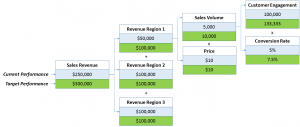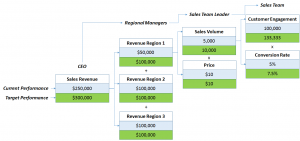This week’s question from the 3 Ps Network: We know we need to measure our performance. But what should we measure specifically? How do we land on the KPIs that really matter?
A Harvard study of 157 businesses revealed that only 23% had completed in depth analysis to set the right KPIs (Source). Using generic or assumed KPIs can result in measuring the elements of your business that have little/no impact on your performance!
So how do you narrow it down to the “critical” KPIs? Here’s how we tackle it!
- Define your business objectives
Define the specific objective/s you want to achieve & how the achievement of those objectives will be measured. Make sure all critical functions of the business are covered:
- Sales – “Generate $300,000 in sales revenue”.
- Operating Costs – “Deliver product unit costs of $2.75 or less”.
- Quality – “Refund less than $10,000 for defective products”.
- People – “Increase employee satisfaction by 10%”.
Use a “gut feel” test to ensure you have a complete set of objectives – “If we achieve these outcomes would we classify ourselves as a “successful” business? If the answer is “no” – define the missing functions and/or objectives.
- Model your business objectives
Model the input drivers that impact your objectives. For simplicity we’ll assume our business sells one product, across 3 regions, at a consistent price.
Business Objective: “Generate $300,000 in sales revenue”.
By modelling the input drivers of sales revenue we have identified the critical KPIs we need to measure: regional sales volume, product sale price, customer engagement volumes & sales conversion rates.
- Allocate KPI accountability at the right levels of the organization
As you move from left to right across the model you can identify the KPIs that need to be set & managed at each level of the business.
The CEO is accountable for total sales revenue. The Regional Manager is accountable for regional sales revenue. The Regional Sales Team Leader is accountable for sales volume & price. The Regional Sales Team is accountable for customer engagement & sales conversion rates.
By allocating KPI accountability at the right levels we can set targets that align the organization & drive achievement of the $300,000 sales revenue objective;
CEO:
- KPI: Total Sales Revenue
- Accountability: Increase Total Sales Revenue from $250,000 to $300,000.
Regional Manager:
- KPI: Regional Sales Revenue
- Accountability: Increase Regional Sales revenue from $50,000 to $100,000.
Sales Team Leader:
- KPIs: Regional Sales Volume & Sale Price
- Accountability: Increase Regional Sales Volume from 5,000 to 10,000 units. Maintain a Sale Price of $10 per unit.
Sales Team:
- KPIs: Customer Engagement Volume & Sales Conversion Rates
- Accountability: Increase Customer Engagement Volume from 100,000 to 133,333. Increase Sales Conversion Rates from 5% to 7.5%.
Everyone from the Sales Team to the CEO are aligned on achieving the $300,000 Sales Revenue objective. Everyone clearly understands what they need to achieve, in order for the business to achieve its objective.
- Frequently review and validate your KPIs
As your business changes, improves & grows your objectives & key drivers will change. It’s critical to refresh your model on a periodic basis to ensure you’re measuring the right KPIs at all levels of the organization.
Got a question on improving & growing your business you’d like answered?
- Reply directly to this post.
- Send us a message on LinkedIn, Facebook, or Twitter
- Send us a message via the “Contact” section of our website.
About 3 Ps in Profit
Our Vision: Enabling more Australian small & medium businesses to succeed & thrive through genuine partnerships that deliver performance improvement & growth.
Our Mission: Improving & growing Australian small & medium businesses by focusing on the three fundamental elements that drive performance; planning & alignment, processes & systems, and people.
Want to find our more? We would welcome the opportunity to discuss your performance improvement objectives and how we can help you achieve them.


